I have to confess: We can be lazy if left to our own devices. We’ll select a single dive destination, park our stuff in a room and proceed to dive ourselves silly from there. What a regrettable mistake that would be in North Sulawesi, Indonesia.
The coastline of this peninsula stretches more than 1,100 phenomenal miles. The waters here hold astonishing coral reefs, some of the most extraordinary and gregarious ocean creatures on the planet and — for your surface interval viewing pleasure — exquisite topside vistas to tie it all together.
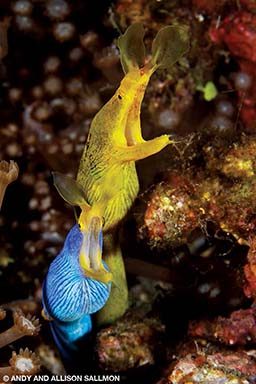
Lembeh Strait: My World, Rocked
It’s my first afternoon in Lembeh, and my old nemesis, jetlag, has caught up with me. I’ve stopped following my eagle-eyed guide and am instead zoning out in front of a ratty clump of bryozoan watching a mantis shrimp, with its cartoony colors and bad attitude. Then I hear a low rumble. The shrimp senses it as well and zips back into his den. The roar becomes louder, and I look down to confirm that the ocean floor is moving.
I’m from California. I know what an earthquake sounds like and feels like; this, my friends, is an earthquake. Andy and I glance at each other in surprise and watch the low coral reef around us shake gently for a minute or two before it finally slows to a stop. I can’t help but think that North Sulawesi is sending me a message: “Hey, pay attention!”

I feel a brief flash of embarrassment — I shouldn’t need a reminder. Lembeh Strait isn’t a place to zone out, at least not while you’re in the water. It’s a place to carefully look around, twice if necessary — a place to scrutinize every crinoid, sponge and patch of sand as amazing creatures can be found nearly everywhere.
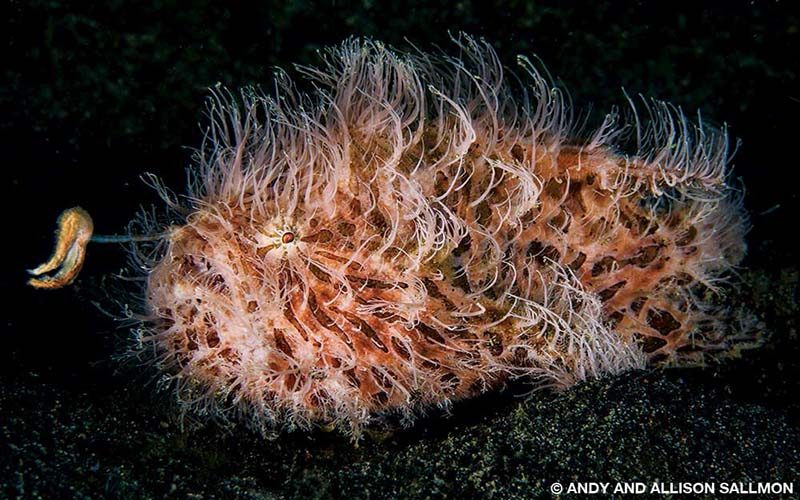
My wake-up call is well-timed, because the glorious muck of the strait struts its stuff in a big way during our visit. We begin the second day at some of Lembeh’s famous black sand sites on the mainland side of the passage. TK, which looks barren from above, produces a wonderpus and longarm octopus, several devil scorpionfish, ribbon eels galore and gobies in every bottle. Nearby Aer Prang seems to have an overarching theme: lunchtime. We spot feasting nudibranchs and an enthusiastically hunting cuttlefish before we begin following a free-swimming black-finned snake eel that’s poking into every hole and nook in search of a meal. He promptly leads us to one of the area’s star residents: a hairy frogfish parading (well, waddling) hungrily across the sand, waving his lure like a flag.
You can bet your own next meal that I’m paying attention now, and I mentally create a list of the weird and wondrous creatures I’d most love to see over the next few days. The reef adjacent to Police Pier gets me close to more than a few; a single dive at this rubbly reef provides photo ops with juvenile painted frogfish, barramundi and batfish as well as a gorgeous harlequin shrimp. It’s a no-brainer to return to this reef at dusk, when the shallow staghorn corals become a hotspot for dozens of canoodling mandarinfish. I’m able to cross off the list a classic local critter at Aer Bajo, where a resourceful coconut octopus has constructed a den from clam shells.
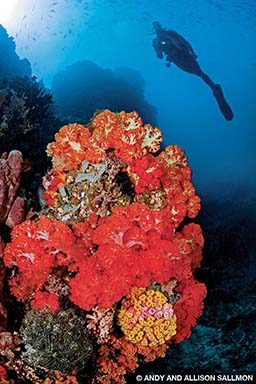
Before the week is over, we also make a point to hit the southern part of the strait to tick off a few final residents. At Goby-a-Crab, we scour soft and whip corals for gobies and search fire urchins for Coleman shrimp. We meet any remaining commensal shrimp quota at Pulau Abadi, where we find cleaner shrimp, anemone shrimp and emperor shrimp in quick succession. With our critter list largely fulfilled, it’s time to venture outside of the strait to visit some of the lushest, richest reefs in the world.
Bangka Island: Tangerine Dream
Our boat pulls up next to the boiling froth of water and foam that marks Sahuang, one of the area’s most renowned sites. “You came from Lembeh, right? Well, don’t worry,” our guide says wryly. “We have frogfish in Bangka, too.”
Darn right they do. We descend toward a massive, dome-shaped seamount, and not five minutes later I’m face to face with what has to be the smuggest giant frogfish on the planet. The handsome, butter-colored fellow preens from his perch — an orange sponge that’s impeccably positioned on a ledge layered with sumptuous orange soft corals. Sunrays glint over one side of the ridge, creating a scene that’s ludicrously gorgeous. I snort enviously at the frogfish, and he stares defiantly back at me, secure in his ownership of such a magnificent piece of property.
I could stay here all day, but our guide has started to move on, and now I’m curious. If this is the scene we’ve dropped in on, what’s around the corner? I kick toward the end of the ledge and am promptly walloped by a stiff current, a challenge that’s worth the effort. As I look around, I realize that the frogfish’s home isn’t unique in its loveliness. Every ridge is covered with masses of orange-hued soft coral, cup coral, fans and sponges, ranging in shade from the deepest yellow to the brightest crimson. Following our guide, we let the flow whip us around the site, tucking behind rocks and boulders to take in the view when we can.
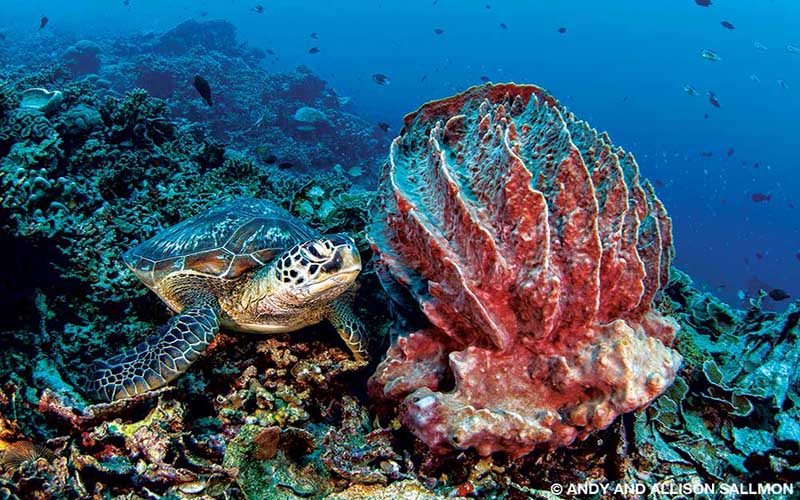
We climb back aboard the boat and motor around the edge of the island to Batu Gosoh (which means “sharpening stone”), appropriately distinguished by surf washing over a corner of stark needlelike rocks. A small wake on one edge of the pillars portends the current, which our guide says is nearly omnipresent at this site. Underwater, the topography is similar and dotted with precariously balanced anemones, clusters of red whip coral and copious tufts of golden soft coral. Andy and I attempt to model for one another, but after being tossed butt-over-teakettle a few times, we give up, deciding instead to weave bravely between sharp rocks toward the other side of the point, where a school of mackerel immediately whizzes past, with a few hungry dogtooth tuna in hot pursuit.
From the boat, Batu Pendita appears to be a nondescript wash rock, but I’ve learned that “nondescript” doesn’t extend beneath the ocean’s surface in Bangka. The current at this site can be extreme; although we’ve timed our visit for slack tide, a hum of urgency penetrates our preparations, and we know we’re on a strict timetable before our dive becomes a 3-knot whirlwind. Under the surface, the color and life are spectacular. Obligatory layers of orange soft coral cover every available surface not occupied by cup corals, and darting clouds of anthias accessorize the whole setup. The bacchanalia has attracted a few hunters: Ravenous lionfish and the occasional color-coordinated scorpionfish can be found where the anthias are thickest. In the distance, I can even make out a few big-boy predators, including barracuda and gray reef sharks.
We’ve battled a lot of current over the past day or two, and now the fatigue must show. On our final afternoon, our guide glances at our weary faces and directs the captain toward Peter’s Sponge, a site located in a small, protected bay. The seafloor here is alternately lined with white sand and seagrass, the latter making this the most common place for lucky divers to spot one of Bangka Island’s most beloved residents: the dugong. This site is otherwise known for incredible macro photography; since we’ve missed the optimal tidal timing to see one of these amazing mammals, I leave behind my camera with a wider lens. Despite the exhaustion that keeps me nearly stationary and the paranoia that compels me to glance over my shoulder every three seconds for the (absentee) dugong, I easily find several longarm octopuses and a colorful flamboyant cuttlefish. I’ll sleep well tonight, and that’s a good thing — tomorrow we’ll begin exploring one of the oldest marine parks in Indonesia.
Bunaken Island and Manado: Inconvenient Turtles
As we motor from our resort in Manado toward the island of Bunaken, the centerpoint of Bunaken National Park, our guide reminds us of a few critical points: This area has been protected since 1991, meaning no touching the coral, no harassing marine creatures and certainly no taking marine life as souvenirs. After the park briefing, a young coral researcher who has spent the past few weeks here sidles up to us to provide her summary impression of Bunaken, one that’s a bit more illustrative: “I’m here to study coral, and most mornings I photograph and document the different corals within the park. The problem is that there are too many turtles and fish at Bunaken.” She sighs in exasperation. “They’re forever getting in the way of my coral shots!” We wait for the punchline, but none comes. It’s clear from her unwavering frown that this woman is 100 percent serious. Andy and I glance at each other in amusement, and then we profusely thank the researcher and rush over to check our camera batteries.
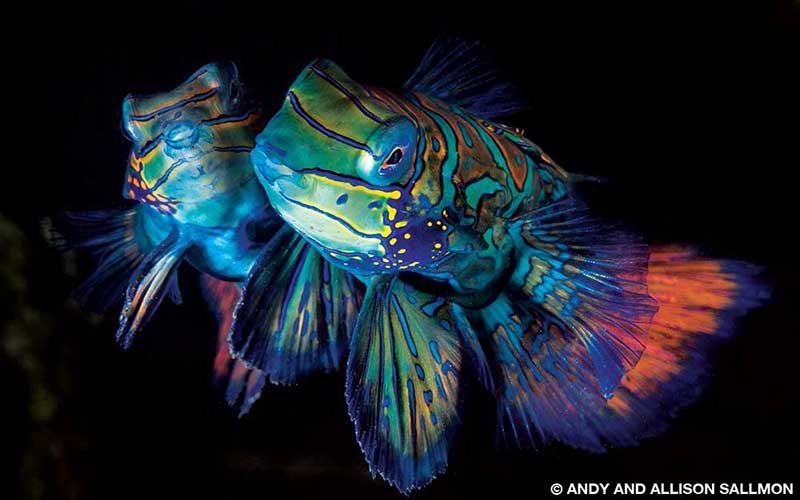
We’re in the water for less than a minute at Sachiko’s Point when we happen across our first green turtle, and it’s no fluke. As we swim along the lavish, sheer wall, we try valiantly to pay attention to multihued soft corals, large sea fans and gigantic barrel sponges, but it’s tough to concentrate when a turtle goes paddling past or a large school of fish streams by every two minutes. My hopes for one lovely reef scenic are dashed when a small cluster of feeding mackerel distracts me, and I blunder another opportunity when a table-sized hawksbill turtle meanders over and begins chomping into a sponge right next to me. I’m not made of steel, after all — how can I resist turning my attention to either one? It’s not long before I’m starting to see the coral researcher’s point.
By the time I dive Fukui, a sloping reef constructed of piles and pillars of hard coral, I have decided that maybe plans are made to be changed. I almost immediately forget my initial goal — to view the cluster of giant clams for which the site is known; between the fish schools streaming over the sloping hard coral reef and a gregarious pair of green turtles that stalk me in tag-team formation, I never see a giant clam. When I get to Bunaken Timor, I’m readily ignoring the towering hard coral wall and door-sized sponges in favor of the hawksbills that lazily saunter past every few minutes.
The only turtleless dives we do on this side of Sulawesi are at the sites just adjacent to Manado, where the macro subjects nearly rival those we saw in the Lembeh Strait. The artificial reef of motorbikes at Tanjung Papaya offers up a cooperative crinoid shrimp, whip coral gobies and a glowering estuarine stonefish; at Bulo we photograph anemonefish and pairs of nudibranchs without a single interruption.
We find that we’re missing the turtles, however, so we make one last late-afternoon dash over to Bunaken to dive Lekuan, a soaring wall famous for large numbers of turtles. We’ve arrived after the morning rush of divers has subsided, which probably explains what we encounter: dozens of green and hawksbill behemoths passed out in every crack and crevice like college kids after exam week.
That night, hours after I’ve packed my gear for the flight home, I’m awakened by a gentle tremor — another tiny earthquake. Even I can’t fathom that a second message is encrypted in the seismic rumbling, so I close my eyes and zone out, thinking of smug frogfish and cranky mantis shrimp, astonishing reefs and gregarious turtles, and of the overwhelming abundance of North Sulawesi.
How to Dive It
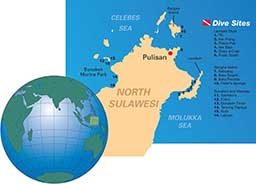
Conditions: The North Sulawesi province encompasses the northern peninsula of the island of Sulawesi. The dry season spans May through September and is generally accompanied by cooler water (75°F to 79°F), good visibility and calmer winds. The rainy season is from November through April and offers higher water temperatures (79°F to 84°F), though visibility can be lower. Typhoons rarely affect this region.
Getting there: Several airlines fly into Manado, which is an excellent jumping-off point for divers visiting the area. Manado and the adjacent Bunaken National Park are located on the northwestern part of the peninsula, with Bangka Island near the northeastern coast and Lembeh Strait to the southeast. Resorts can often arrange a combination of land transfers and water taxis for divers who wish to visit more than one location during their stay, and a few offer “boat diving” transfers for those who prefer to dive lesser-visited sites as they make their way around the peninsula.
A recompression chamber is in Manado.